Nitrogen and phosphorous are important tools for aquaculture pond management
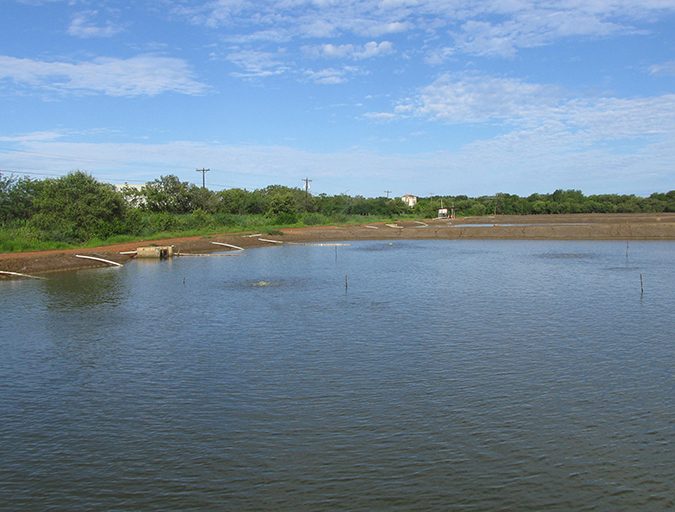
Phytoplankton require oxygen, carbon, hydrogen, plus 12 to 15 mineral elements as nutrients for growth. Oxygen is produced by phytoplankton in photosynthesis, carbon is obtained from carbon dioxide and bicarbonate dissolved in water, and hydrogen is available from water. The mineral nutrients include nitrogen (from ammonium or nitrate), phosphorus, sulfur, calcium, magnesium, potassium, sodium, and chlorine, iron, manganese, zinc, copper, boron, and depending upon the species, a few others. In addition, diatoms have a large requirement for silicon.
The production of phytoplankton, including those in aquaculture systems, is limited mainly by concentrations of ammonium, nitrate, and phosphate. Thus, nitrogen and phosphorus fertilizers are often used in ponds when it is desired to stimulate phytoplankton growth. Silicon fertilization is sometimes conducted in shrimp ponds to promote diatom growth. Potassium fertilization may be required in a few ponds, and trace element fertilization has been used – mainly in ponds filled with brackishwater or seawater. Inorganic fertilizers also have been used for adjusting the proportions of cations to prevent ionic balance from affecting shrimp in low-salinity, inland ponds.
Nitrogen and phosphorus most important
The widely-held opinion that only nitrogen fertilization is necessary to stimulate phytoplankton growth in seawater and brackishwater cannot be supported by scientific evidence. A recent review published by a group of ecologists in a major scientific journal concluded that nitrogen and phosphorus were the most important limiting nutrients across terrestrial, freshwater, and marine ecosystems.
The nutrients in chemical fertilizers have traditionally been expressed as percent N, percent P2O5, percent K2O, but there is increasing reference to fertilization rates in terms of N, P, and K. The traditional P2O5 and K2O values can be converted to P and K by multiplication by 0.437 and 0.83, respectively.

The nitrogen in fertilizer is in form of ammonium, nitrate, or urea. Urea is an organic nitrogen compound (CH4N2O), but when put in water it quickly hydrolyses to ammonia nitrogen and carbon dioxide. The phosphorus in fertilizer is not P2O5; it is from phosphates (H2PO4– or HPO42) of calcium, ammonium, or potassium. Likewise, there is no K2O in a fertilizer. Potassium usually is present as its chloride, but sometimes as sulfate, nitrate, or phosphate. The compositions of some common fertilizers are provided in Table 1.
| Chemical compound | Common name | Primary nutrient % (N) | Primary nutrient % (P2O5) | Primary nutrient % (K2O) |
|---|---|---|---|---|
| Urea [(CO(NH2)2] | Carbamide | 45 | 0 | 0 |
| Calcium nitrate [Ca(NO3)2] | CAN | 15 | 0 | 0 |
| Sodium nitrate (NaNO3) | Chile saltpeter | 16 | 0 | 0 |
| Ammonium nitrate (NH4NO3) | Nitrate of ammonia | 33-25 | 0 | 0 |
| Ammonium sulfate [(NH4)2SO4] | – | 20-21 | 0 | 0 |
| Phosphoric acid (H3PO4) | – | 0 | 54 | 0 |
| Monocalcium phosphate [Ca(H2PO4)2H2O and CaSO42H2O] | Superphosphate | 0 | 16 | 0 |
| Monocalcium phosphate [Ca(H2PO4)2H2O] | Triple superphosphate | 0 | 44-54 | 0 |
| Monoammonium phosphate (NH4H2PO4) | MAP | 11 | 48-52 | 0 |
| Diammonium phosphate [(NH4)2HPO4] | DAP | 18 | 48 | 0 |
| Ammonium polyphosphate [NH4PO3]n | APP | 11-13 | 37-38 | 0 |
| Potassium nitrate (KNO3) | Salt peter | 13 | 0 | 46 |
| Potassium chloride (KCl) | Muriate of potash | 0 | 0 | 60 |
| Potassium sulfate (K2SO4) | Glaser's salt | 0 | 0 | 50 |
Fertilizer solubility and blending
Fertilizers are highly soluble in water – the main exceptions being sodium and calcium silicate that have relatively low solubility. Most fertilizers are in the form of granules or prills that are considerably denser than water. In spite of high solubility, nitrogen, phosphorus, and potassium fertilizers – especially phosphorus containing compounds – sink to the bottom before dissolving well. Once at the bottom they completely dissolve, but phosphorus is rapidly adsorbed by the bottom soil. It is much more effective to pre-dissolved fertilizers in water before applying them over the pond surface. There is little advantage to using the more expensive liquid fertilizers in aquaculture. Liquid fertilizers also are denser than water and should be mixed with water before application to lessen their density and avoid them from sinking before mixing with water.
Fertilizer compounds often are blended to provide a mixed fertilizer containing nitrogen, phosphorus, potassium, and possibly other elements in a single product. For example, urea, triple superphosphate, potassium chloride, and a limestone filler (for adjusting weight of total ingredients to achieve desired nutrient percentages) could be blended to manufacture a 20 percent N, 10 percent P2O5, 5 percent K2O fertilizer. This is a convenient practice in terrestrial agriculture, but blended fertilizers are not used very much in aquaculture. It usually is more convenient in aquaculture to weigh out specific quantities of fertilizer compounds and apply them to ponds.
Application rates to ponds
Typical fertilizer application rates to ponds are 5-10 kg/ha of N and P2O5/ha. For example, to treat a 1-ha pond with 10 kg/ha N and 5 kg/ha P2O5 (»2.2 kg/ha P), one could apply 22.2 kg/ha urea (10 kg/ha ¸ 0.45 kg N/kg urea) and 10.9 kg triple superphosphate (5 kg/ha ¸ 0.46 kg P2O5/kg triple superphosphate). Some farmers try to achieve a particular concentration of nitrogen and phosphorus in water; but, fertilizer nutrients are quickly removed from pond water by chemical and biological processes making it impossible to achieve a specific nutrient concentration. Ponds do not vary greatly with respect to volume per unit area, and the traditional weight/unit area application probably results in less variation in nutrient concentration increase following fertilization than some may think.
Fertilizer nutrients are rapidly removed from pond waters by various physical, chemical, and biological processes. This results in fertilizers having to be applied at frequent intervals of 1-4 weeks. Frequency of application can be adjusted in accord with phytoplankton abundance. When the water has plenty of phytoplankton, the application may be delayed. But, it is critical not to allow the phytoplankton abundance to become too low before applying another fertilizer application.
Pond fertilization is less effective in low alkalinity water (<40 mg/L) than in waters of greater alkalinity. Thus, low alkalinity water should be limed to improve their response to fertilization. Urea and ammonium-containing fertilizers are acid-forming because of oxidation of ammonium (urea hydrolyses to ammonia nitrogen) to nitrate, and these fertilizers cause alkalinity to decline. There also are other sources of acidity in ponds, and alkalinity is lost by overflow and draining for harvest. Liming usually has to be repeated annually or more often in ponds in areas with naturally low-alkalinity water.
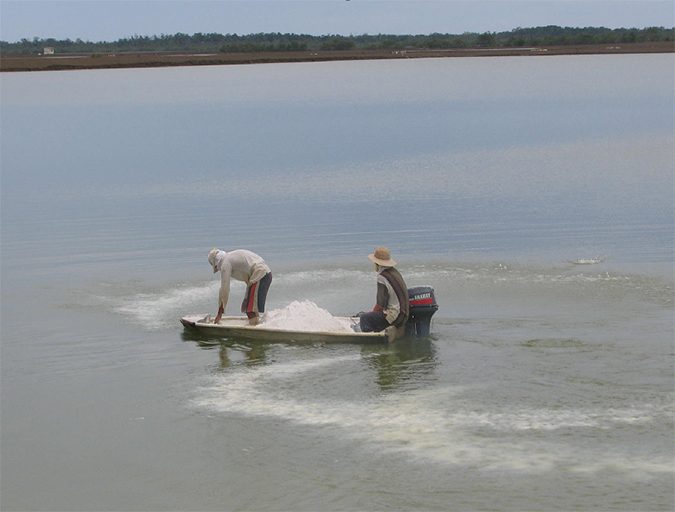
Other factors affecting pond response
A number of other factors affect the response of a pond to fertilization. These include excessive water flow that flushes out nutrients, aquatic weeds that compete with phytoplankton for nutrients, excessive turbidity from suspended soil particles that restrict light penetration for photosynthesis, a nutrient not contained in the fertilizer that may be limiting, high pH and calcium concentration in the water that precipitates calcium phosphate, and unknown factors. As a result, no two ponds – even when located side-by-side – are identical. Pond fertilization is an art, and pond managers must ultimately try different fertilization regimes until a satisfactory one is found.
The results of research have led to many different recommendations on the nutrients that should be contained in a fertilizer, the amounts of each nutrient to add per application, frequency of application, etc. However, research findings strictly apply only to particular place, and more precisely to particular ponds. This is the reason for the wide differences in recommendations, and one cannot expect a single recommendation to apply everywhere. Nevertheless, research findings provide guidelines for pond managers to use in developing an adequate fertilization regime for a specific pond or production facility.
Much less is known about fertilization with silicate and trace elements than with nitrogen and phosphorus fertilization. There are studies showing that additions of silicate, nitrate, and especially a combination of both stimulated diatoms in brackishwater shrimp ponds. However, the effective rates for both silicate and nitrate were much higher (5-10 times greater) than those commonly used by pond managers. There also is evidence that iron fertilization enhances phytoplankton productivity in ponds filled with seawater or brackishwater. However, the economic benefits of silicate and iron fertilization have not been established.
Perspectives
Nitrogen and phosphorus are the most important nutrients in fertilization of both freshwater and coastal ponds. Liming is required to improve effectiveness of fertilization in pond with alkalinity <40 mg/L. Many factors affecting the response of ponds to fertilizers are location specific. The pond manager should be aware of recommendations on fertilization regimes developed in research, but usually will have to figure out the best procedure for a given location or even for an individual pond.
Author
-

Claude E. Boyd, Ph.D.
School of Fisheries, Aquaculture and Aquatic Sciences
Auburn University
Auburn, AL 36830 USA
[117,100,101,46,110,114,117,98,117,97,64,49,101,99,100,121,111,98]
Related Posts
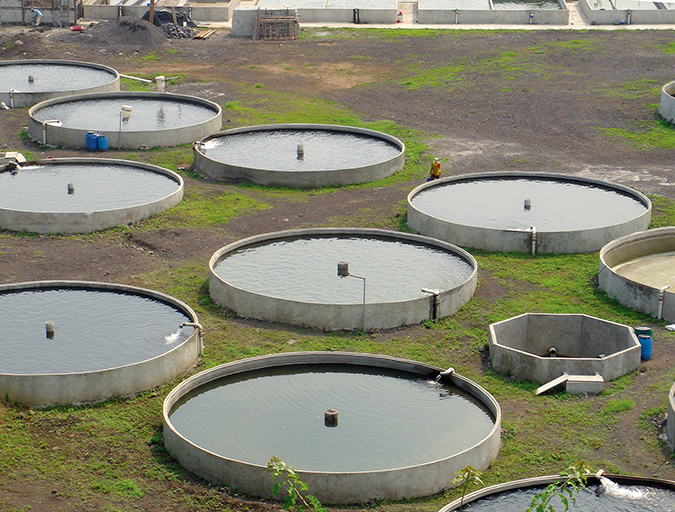
Responsibility
Calcium and magnesium use in aquaculture
Aquatic plants and animals get the essential nutrients calcium and magnesium from water and food. Calcium concentrations impact the hydration and development of eggs in a hatchery, where calcium carbonate precipitation can be troublesome.
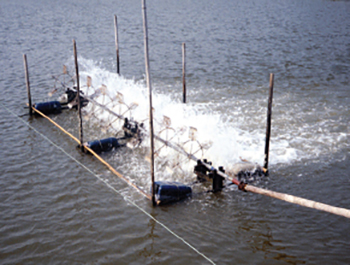
Responsibility
Efficiency of mechanical aeration
Although relatively expensive, mechanical aeration increases production. Asian-style paddlewheel aerators are widely used but are inefficient. Testing has led to more efficient designs that are now widely used in U.S. catfish and shrimp ponds.
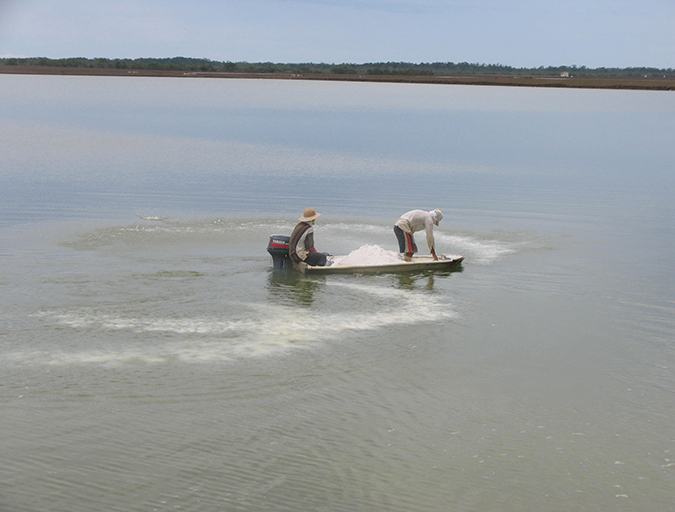
Responsibility
The importance of liming materials in aquaculture
Liming is an important management tool for preparing aquaculture ponds between and during production cycles. Several products are sometimes used in aquaculture for liming production ponds, including agricultural limestone, calcium silicate (CaSiO3) and sodium bicarbonate (NaHCO3).
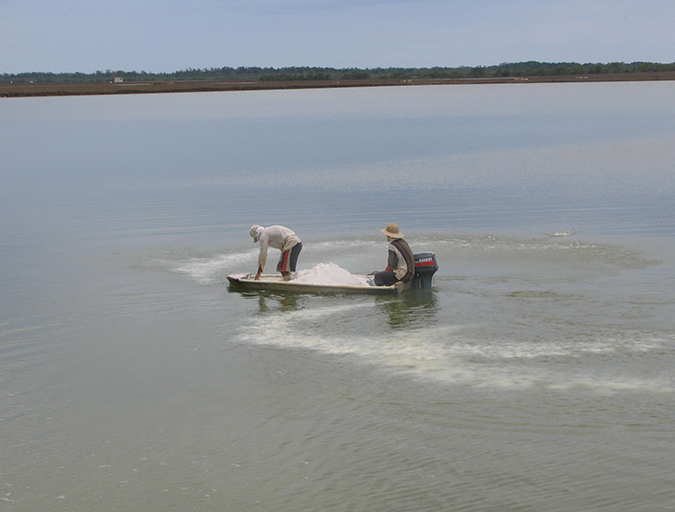
Responsibility
What causes alkalinity changes in aquaculture waters?
Total alkalinity is an important variable in water for aquaculture systems, and its concentration frequently fluctuates over time in many culture systems.

